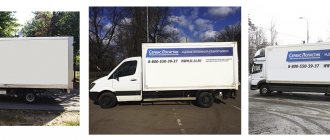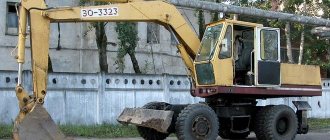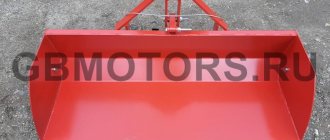To deliver large cargo over long distances in the shortest possible time, truck transportation is most often used. The popularity of this type of cargo transportation is primarily due to the efficiency and efficiency of the services provided. To determine the weight and possible volume of transported cargo, you need to take into account the carrying capacity and dimensions of the truck.
The dimensions of a truck usually mean the dimensions of a semi-trailer (Eurotruck or Eurotent). The capacity or useful volume of a semi-trailer depends on its length, width and height. Semi-trailers come in different types: tilt, isothermal, refrigerated and open.
Tilt eurotruck 20 tons
A 20 ton Eurotent tilt truck is the most common vehicle for transporting most cargo. The curtainsider semi-trailer can be completely retracted, so loading and unloading can be done from four sides: rear, top and side. The racks of the frame and sides of the Eurotruck semi-trailer can also be removed, which allows you to load long cargo. Thanks to this versatility, Eurotrucks are most widely used. The standard capacity of a tilt truck is 33 Euro pallets measuring 120 cm x 80 cm, and the carrying capacity allows you to load 20 - 24 tons of cargo. The most common currently in Russia are tilt semi-trailers from the manufacturers Kogel, Lamberet, Krone and Schmitz.
Layout of pallets in a Eurotruck
There are a large number of modifications of semi-trailers, among which the most common are: Semi-trailers with a volume of 55-80 m3, have a shorter length of 10-13 m, a width of 2.4-2.42 m and a height of 2.3 m. Semi-trailers with a volume of 80 -120 m3, have a length of 13.6 m, a width of 2.45 m, and a height of 2.45-3 m.
Eurotruck 82 cu.m. m. (EURO)
Internal length - 13.6 m Internal width - 2.45 m Internal height - 2.45 m Loading capacity (tonnage) - 20-22 tons Standard tilt semi-trailer with a flat floor.
Eurotruck 86 cu.m. m. (EURO)
Internal length - 13.6 m Internal width - 2.45 m Internal height - 2.60 m Loading capacity (tonnage) - 20-22 tons Standard tilt semi-trailer with a flat floor.
Eurotruck 90 cubic meters m. (EURO)
Internal length - 13.6 m Internal width - 2.45 m Internal height - 2.70 m Loading capacity (tonnage) - 20-24 tons Standard tilt semi-trailer with a flat floor.
Eurotruck 92 cu.m. m. (EURO)
Internal length - 13.6 m Internal width - 2.45 m Internal height - 2.80 m Loading capacity (tonnage) - 22-24 tons Standard tilt semi-trailer with a flat floor.
Eurotruck 96 cu.m. m. (EURO)
Internal length - 13.6 m Internal width - 2.45 m Internal height - 2.90 m Loading capacity (tonnage) - 22-24 tons Standard tilt semi-trailer with a flat floor.
Jumbo truck 96 cu. m. (JUMBO)
Internal length - 4.2 + 9.4 = 13.6 m Internal width - 2.45 m Internal height - 2.45 and 3.0 m Load capacity (tonnage) - 22-24 tons. Semi-trailer with a “broken” frame, L-shaped floor base, reduced diameter of semi-trailer wheels.
Mega truck 100 cubic meters m. (MEGA)
Internal length - 13.6 m Internal width - 2.45 m Internal height - 3.0 m Loading capacity (tonnage) - 22-24 tons. A tilt semi-trailer with a flat floor and high height.
110 cc hitch m.
Internal van length - 7.1 m Internal trailer length - 8.0 m Internal van and trailer width - 2.45 m Internal van height - 2.95 m Internal trailer height - 3.0 m Load capacity (tonnage) - 22-25 tons. A road train consists of a coupling of a car and a trailer.
MEGA 120 cc hitch m.
Internal van length - 8.0 m Internal trailer length - 8.0 m Internal van and trailer width - 2.45 m Internal van height - 2.95 m Internal trailer height - 3.0 m Load capacity (tonnage) - 22-25 tons. A road train consists of a coupling of a car and a trailer.
Refrigerated truck 86 cubic meters. m. (Ref)
Internal length - 13.6 m Internal width - 2.45 m Internal height - 2.6 m Loading capacity (tonnage) - 20-22 tons. The semi-trailer is equipped with an autonomous refrigeration unit, which allows maintaining a certain temperature inside from -20°C to +12°C throughout the entire route, regardless of the external temperature. Refrigerators cool cargo in summer and heat it in winter. Refrigerated trucks are divided into classes according to the European classification ATP Europe: ● Class A refrigerated truck: temperature from 0°C to +12°C. ● Class B refrigerated truck: temperature from -10°C to +12°C. ● Class C refrigerated truck: temperature from -20°C to +12°C. ● Class D refrigerated truck: temperature from -20°C to +2°C. ● Class E refrigerated truck: temperature from -20°C to -10°C. ● Class F refrigerated truck: temperature up to -20°C.
Isothermal truck 86 cubic meters. m. (Thermos)
Internal length - 13.6 m Internal width - 2.45 m Internal height - 2.6 m Loading capacity (tonnage) - 20-22 tons. The walls of the semi-trailer consist of heat-insulating materials, which allows maintaining the initial temperature of the cargo for a short time.
>
Classification of road trains
Road trains have different configurations, which differ in the traction machine, type and number of trailers. Depending on the type of cargo, the appearance and functionality of trailed equipment changes. There are universal and highly specialized trucks.
By type of semi-trailer
Of course, the classification of a road train depends on the semi-trailer. It is the hitch that determines the type of cargo being transported. Universal trucks capable of transporting different types of products include:
- Onboard. They are a platform without a roof with folding or removable sides on the sides. With the help of a crane, such a machine can be quickly loaded or unloaded. They are used to transport goods without special transportation requirements - pipes, bricks and some building materials, metal structures, etc. If necessary, an awning can be installed on the sides. And then we get the following type of road train
- Tents (Eurotrucks). A platform equipped with a steel frame on which a dense awning, made mainly of PVC or rubberized tarpaulin, is stretched. The awning can be installed and removed completely or moved from the side, similar to the principle of curtains.
- Curtains. This is one of the types of tilt semi-trailers, only the awning is divided into three parts: two side and ceiling. This is done for ease of loading and unloading. Another difference from their tented counterparts is the presence of a rear portal gate.
- Curtain-sided. They are a compromise solution that combines the design of curtain-side and flatbed semi-trailers. In addition, their awning can be attached not only to the base, but also to the edge of the side.
By purpose
To transport goods that require special transportation conditions, special semi-trailers are used.
- Trawls. These heavy trucks are used for transporting indivisible cargo of large size and weight, as well as for transporting various machinery and equipment. Depending on the load capacity, they can have from two to ten axles.
- Container ships. They are designed for transporting sea and rail containers. Container trucks are used for multimodal transportation. Most often, cargo transportation is carried out from ports or railway stations to storage areas. The design feature is a sliding frame.
- Refrigerators. Used for transporting perishable products, flowers, frozen semi-finished products that require special temperature conditions. They have a refrigeration unit that maintains the set temperature even during frost or extreme heat. The body is made of sandwich panels filled with foam. Refrigerators have several classes depending on the temperature they maintain.
- Isothermal. The sides of these trailers are made of multi-layer panels. They are a “light” version of refrigerators and are designed to maintain internal temperature by reducing heat exchange with the environment. Used for transporting chilled products that do not require freezing, bakery products.
- Tanks. There are conventional and isothermal models, equipped with cooling or heating units. Designed for transportation, temporary storage and dosing of liquid products: fuels and lubricants, food, chemicals. The design features of such trailers depend on the requirements for the transportation of liquid cargo and their intended purpose.
- Tipper. Externally similar to onboard ones, but equipped with a lifting mechanism. The tilt can be lateral or longitudinal. Loading can be rear or side. They are mainly used for transporting bulk cargo. Some models are equipped with stone chippers. There are options with bottom unloading, for filling roads and transporting grain and cement.
- Cement trucks, flour trucks. Such trucks have a specially designed semi-trailer for transporting fine bulk cargo. Equipped with special upper hatches for loading and lower hatches for unloading.
- Jumbo. The semi-trailer is of non-standard design, consists of two parts of different heights. The wheel diameter is smaller than other models.
In addition to the main types, there are also vertical and cassette semi-trailers for transporting reinforced concrete products, glass; transport for transporting animals, cars, pipes, etc. For each type of cargo, certain semi-trailers are used that meet transportation requirements and are optimized for narrow specifics.
Truck height from floor to roof
The truck's carrying capacity is less than that of a Euro truck. However, it has more usable space.
Dimensions of the awning and semi-trailer from floor to roof
These include:
- Mega road trains are semi-trailers that have a flat floor. At the same time, the height of the truck from the ground to the top reaches 3.2 m.
- Hitches with a volume of 100–130 cubic meters.
- Semi-trailer “Jumbo” with a carrying capacity of up to 20 tons, where the volume is increased thanks to the L-shaped floor, but the height is unchanged.
Leading manufacturers
Russian entrepreneurs choose semi-trailers with a high degree of reliability, good maneuverability, and low fuel consumption.
The following brands of cars are popular in the domestic market:
- Scania
- MAN.
- MAZ.
- Iveco.
In the expensive segment, preference is given to the brands TATA Motors Limited, Next and Mercedes. The presented companies started their business with the production of military equipment, therefore the vehicles they produce are distinguished by high wear resistance and engine power.
Features of refrigerator repair
The main causes of ref breakdowns include:
- failure of vehicle components (engine, headlights, brakes, instruments, etc.);
- body defects (cracks, creases, damage to the insulating lining);
- malfunctions in the operation of refrigeration equipment (freon leakage through damaged hoses, tubes, seals; malfunctions of the condenser or evaporator units, breakdown of the control system, compressor, failure of the filter drier, overheating or accumulation of frozen ice on the surface of the evaporator, etc.)
You can fix automotive problems yourself. Repairing a refrigerator will require the intervention of specially trained technicians.
If a sandwich panel fails, it is necessary to accurately calculate the location and load-bearing capacity of the frame with the refrigeration unit in order to carry out the correct replacement. It is important to consider that the operation of the unit is accompanied by vibration, and the frame of the front panel requires a rigid, reliable connection with the side panels, roof and floor.
Detailed information is visible in the video:
Vehicle weight
How much the truck will weigh depends on the model of the tractor and semi-trailer. On average, a tilt semi-trailer weighs 6.5 - 7 tons, a refrigerator weighs about 9 tons, plus the weight of the tractor is another 6-7 tons.
The weight of the truck must be taken into account, since the maximum load and, as a result, the income of the transport company will depend on it. Semi-trailer manufacturers are constantly looking for ways to reduce the weight of their products so that the customer can use it more efficiently.
Note!
The lower the weight of a semi-trailer with the same number of wheels, the more cargo can be transported.
What is included in the concept of “dimensions”
The concept of “truck dimensions” includes the dimensions of the semi-trailer, capacity (sometimes used as useful volume), which depend on the internal length, width and height. It is important to know the dimensions of the machine in order to understand what can fit and in what volumes.
Vehicles that have a semi-trailer axle lifting crane can carry more weight due to the additional wheelset.
Types of cargo transported
“Curtain-maker.”
The Eurotruck transports:
- construction material;
- household appliances;
- things packed in containers;
- furniture.
Not all types of cargo are transported using a standard “European”. Perishable foods, flowers, and medicines require specially installed refrigerators. Bulk cargo (wheat, sand, gravel) is best transported on dump trucks. Manufacturers produce tanks to deliver all types of liquids.
Load capacity
The maximum load capacity of a truck is calculated based on axle load standards for different categories of roads. However, there is an average calculation for most Russian highways. The table shows the most common data:
| Number of tractor axles | Number of semi-trailer axles | Gross truck weight, t | Maximum cargo weight, t |
| 2 | 2 | 36 | 22 |
| 2 | 3 | 38 | 24 |
| 3 | 2 | 37 | 23 |
| 3 | 3 | 38 | 24 |
Important!
When loading the truck, you must remember to correctly distribute the load along the axles.
This is an average calculation, which may deviate in one direction or another depending on the specific road train. More accurately, the load capacity of a truck can be calculated based on the official requirements for axle loads. They can be found in Decree of the Government of the Russian Federation dated April 15, 2011 N 272 (in the current version) “On approval of the Rules for the transportation of goods by road.”
Number of axes
As a rule, curtainsider semi-trailers have three wheel pairs. This allows you to more evenly distribute the load on the axles, improves braking, and reduces the impact on the road surface. The wear of the chassis occurs more evenly. As the number of axles increases, fuel costs increase.
The arrangement of cargo inside the trailer will depend on the number of axles in order to avoid overloading, but load the vehicle as much as possible.
Where can I buy
Dealers of truck manufacturers offer to purchase European standard subs on official websites at a price of 1,500,000 rubles. For example, the cost of the Euro-platform Lawn-Next is 2,130,000 rubles. The pages of the portal offer photographs of cars, videos, pictures with diagrams and the method of arranging pallets. Here you can get expert advice and agree on payment details.
Sellers work directly with credit institutions (you can buy tractors using a loan). The website allows you to order a fleet of different types of trucks.
For example, farmers who grow vegetables, fruits, and grains with their own hands can agree on an installment plan.
How to calculate useful volume
In order to calculate the cost of cargo transportation and order the necessary vehicle, you first need to find out its capacity .
Useful volume is the internal cubic capacity excluding the cabin. That is, the space that is used specifically for cargo.
The formula for calculating useful volume is simple: width × length × height. But often semi-trailers do not have a roof (open platforms and trawls), then it is easier to use online calculators for the exact size. For example, https://www.searates.com/ru/reference/stuffing/. Although there are still many similar sites on the Internet:
Buy or rent
The choice between purchasing or renting special equipment depends on the intended purpose and parameters of the devices. For example, vehicles equipped with Eliwell will cost several thousand more.
Objective information can be obtained after viewing video and photographic materials.
The right approach to selecting transport is the key to building a successful business in the field of cargo transportation. If you do not have the amount necessary for purchase, you can consider rental or leasing options. This type of cooperation affects the quality of vehicles: each new owner reduces the operating capabilities of the equipment.











